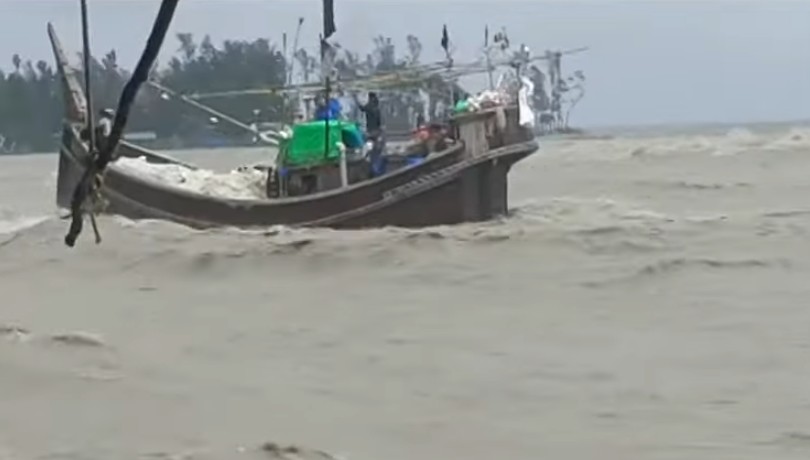Unusually high tides, triggered by a deep depression over the northern Bay of Bengal during the new moon on Thursday, have swamped low-lying areas in at least 16 coastal districts, creating a disaster-like situation along the southern coastal belt and adjoining areas.
Strong winds, combined with tidal surges of 1 to 3 feet, flooded villages in Barguna, Patuakhali, Bhola, Noakhali, Satkhira, Khulna, Bagerhat, Chattogram, and Cox’s Bazar by Friday, damaging homes, fish enclosures, and croplands. Erosion has also battered parts of Cox’s Bazar’s Marine Drive, while all water transport services remain suspended due to safety concerns.
Rivers in the coastal region are flowing above danger levels under the combined effect of the depression and the new moon. In Patuakhali’s Rangabali upazila, river levels rose by 3 to 4 feet, submerging hundreds of households and ponds, according to reports from the affected areas.
The deep depression formed over the northern Bay of Bengal during the new moon on Thursday intensified and moved towards Bangladesh’s coastline, flooding low-lying areas in at least 16 coastal districts by Friday.
The combined impact of strong winds and unusually high tides created a disaster-like situation in parts of Barguna, Patuakhali, Bhola, Noakhali, Satkhira, Khulna, Bagerhat, Chattogram, and Cox’s Bazar. Several coastal villages have been submerged under tidal surges of 1 to 3 feet, while water transport services were suspended.
According to our sources, rivers in southern Bangladesh are flowing above the danger level due to the low-pressure system. The simultaneous effect of the new moon led to abnormal tidal waves, which inundated riverside settlements. On Friday morning, the system was located around 110 km from Payra Port, raising river levels by 3 to 4 feet in Rangabali upazila of Patuakhali. Homes, fish enclosures, ponds, and croplands were submerged, and parts of Cox’s Bazar’s Marine Drive have been damaged by erosion.
The Bangladesh Meteorological Department (BMD), in its latest bulletin on Friday evening, said the depression crossed the coastal regions of Indian state of West Bengal and Bangladesh around 3 pm and is currently located over Gangetic West Bengal, adjoining the north-west Bay, and coastal Bangladesh. The monsoon is active over Bangladesh and strong over the Bay. Under its influence, light to moderate rains, accompanied by gusty winds, are occurring in various regions, with heavy to very heavy rainfall expected at places, particularly in Khulna, Barishal, and Chattogram divisions.
Weather expert Mostafa Kamal, analysing satellite images received from Japan, forecasted continued rainfall across all districts until Monday. He noted that heavy rain had already lashed Khulna, Barishal, Chattogram, and Dhaka divisions, with coastal districts experiencing wind speeds of 40–60 km/h. Fishermen have been advised not to venture into the sea until further notice.
Dr Omar Faruq, another meteorologist, confirmed that the depression began crossing the West Bengal-Bangladesh coast on Friday afternoon and might weaken. However, it could still cause stormy winds and tidal surges. Authorities have instructed Chattogram, Cox’s Bazar, Mongla, and Payra seaports to hoist local cautionary signal No. 3. Fishing boats and trawlers in the Bay have been asked to remain in safe shelters.
The Flood Forecasting and Warning Centre (FFWC) reported that low-lying coastal areas are at risk of flooding due to the depression and new moon. According to its bulletin, rivers in Barishal, Khulna, and Chattogram divisions are under the influence of high tides, and tidal surges 1–3 feet higher than normal are expected in the next 24 hours. Heavy rainfall in Chattogram over the last 24 hours has worsened the situation, although there has been no significant upstream rainfall.
The FFWC warned that water levels in several rivers, including Feni’s Muhuri and Selonia, could rise above danger levels, causing flooding in parts of Feni district. Rivers such as Feni, Halda, Sangu, Matamuhuri, Rahmatkhali Khal, and Noakhali Khal in Chattogram, Bandarban, Cox’s Bazar, Lakshmipur, and Noakhali are expected to swell and overflow low-lying areas. In Sylhet, the Manu, Dholai, and Khowai rivers are rising and may continue to do so for three days, while the Surma and Kushiyara are showing signs of gradual decline.
Meanwhile, the Indian Meteorological Department reported heavy to very heavy rainfall across South Bengal, which is expected to continue until Tuesday. The depression is forecast to move towards north Odisha, Jharkhand, and Chhattisgarh.
South rivers flow above danger level
The tidal surge, intensified by heavy rainfall and the depression, caused water levels in all southern rivers to rise above the danger mark, inundating vast areas. On Friday afternoon, several roads in Barishal, including the city’s main Sadar Road, went under water, along with homes along the Kirtankhola riverbanks.


